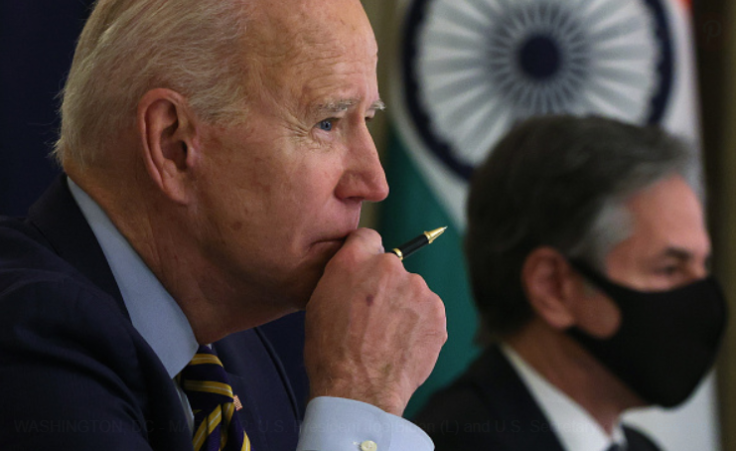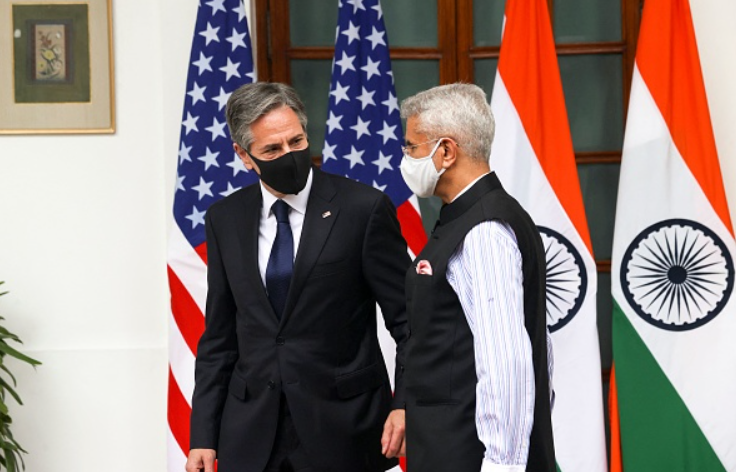
July 2021 marked not only the first six months of Joe Biden’s presidency, but also U.S. Secretary of State Anthony Blinken’s first official visit to India. The secretary arrived in Delhi on July 28, where he met with Prime Minister Narendra Modi and External Affairs Minister (EAM) S. Jaishankar, among others. Since joining Biden’s cabinet, Blinken has recognized India as a “bipartisan success story” and reemphasized Biden’s “terrific vision” of making the United States and India the “closest nations in the world.” Under Biden, Delhi-Washington ties have continued a gradual upward trajectory with multiple high-level interactions, although persisting gaps continue to hinder the realization of the bilateral relationship’s full potential. Moving forward, both sides must make a synergistic effort to address these gaps and establish a defining global partnership in the era of great power competition.
An Indo-Pacific Values-based Partnership
Following the bonhomie between Trump and Modi, the upward trajectory in U.S.-India ties has continued under Biden’s push to restore and strengthen American alliances in the Indo-Pacific. Much of the synergy between the United States and India has taken place in the context of the Quadrilateral Security Dialogue (Quad), amongst other matters like health cooperation. The U.S.-proposed Quad Leadership Summit in March, along with the group’s first-ever joint statement with leaders from the United States, India, Japan, and Australia was an important step in Biden’s outreach. High-level exchanges including U.S. Secretary of Defense Lloyd Austin and Special Presidential Envoy for Climate Change John Kerry visits to India in March and April 2021 respectively, EAM Jaishankar’s U.S. visit in in May, and phone conversations between Modi and Biden and U.S. National Security Advisor Jake Sullivan and his Indian counterpart Ajit Doval, have underscored this upward trajectory and interest in taking forward bilateral ties with a comprehensive focus.
Despite growing synergy, the United States and India do not have absolute confidence in one another.
Blinken’s visit to New Delhi reflected the growing scope of the relationship as conversations covered a range of issues including COVID-19, Indo-Pacific security concerns, human rights, climate change, and crucially, the situation in Afghanistan. In meetings with civil society groups, the U.S. brought up concerns in India’s domestic politics and the stressed democratic foundation of their relationship. Notably, democratic values were also used to contrast the U.S.-India relationship with China’s role in the region. In a tacit nod at China, Blinken met separately with Tibetan representatives and highlighted the shared democratic values of the U.S.-India partnership and its symbolic value in the face of a “democratic recession” across the world. This emphasis on democracy in the U.S. visit drew a strong response from Beijing, which criticized American democracy as hegemonic.
Continued Hiccups and Glaring Gaps
Despite growing synergy, the United States and India do not have absolute confidence in one another. The United States has been wary of India’s resistance to an outright security alliance, and India has been frustrated by being viewed as a subordinate power in the relationship. This has contributed to miscommunications. For instance, the Freedom of Navigation exercises by the U.S. Navy’s Seventh Fleet inside India’s Exclusive Economic Zone in the Indo-Pacific without prior consent, as well as its later forceful statement on its navigational rights in the area, were not well received in India. Washington’s de facto embargo on critical vaccine raw materials was another such misstep, which was quickly resolved by Biden reversing his decision and lending considerable aid to India’s vaccine program.
There are also remaining gaps in the regional economic outlooks of the India-U.S. partnership. Washington has sought to take forward sustainable quality infrastructure via the Blue Dot Network (BDN) with co-leaders Japan and Australia, and now build a grander alliance through the Build Back Better World (B3W) with G7 countries. India remains absent from these endeavors. Although New Delhi has expressed interest, its evasion stems from two concerns: first, it is hesitant to committing financially as a developing economy; second, it wishes to maintain strategic caution vis-à-vis China. Joining BDN/B3W could be seen in Beijing—already expressing public objection to the still informal Quad—as a deliberate attempt from New Delhi to create a more formal anti-China bloc, which would further deteriorate Sino-Indian ties.

Further, there has been an ongoing gap in Washington and Delhi’s preferred trade policies. Despite steady growth in bilateral trade from USD $16 to $146 billion from 1999 to 2019, long-standing disagreements over critical issues like high-end technology trade, agriculture trade, market access, foreign investment, and intellectual property rights continue to plague trade relations. The gulf between the two states is underscored by their failure to produce even a limited trade agreement in 2020. India under Modi has taken on a protectionist character, although this is expected to change under Delhi’s post-pandemic recovery plans. Thus far, Biden’s trade policy has not been a complete break from the Trump administration, as protectionism continues to dictate the administration’s stance in the pandemic. This indicates that despite the political momentum of the strategic partnership, ongoing challenges from the pandemic and continued gaps may continue to be a thorn in the side of U.S.-India bilateral relations.
The Way Forward
For U.S.-India ties to reach their loudly espoused potential, both states must make a focused effort to pursue the Indo-Pacific and global dimension of their strategic partnership with four major areas of focus: multilateral initiatives, supply chain network diversification, trade, and defense.
India and the United States each stand to gain by furthering a shared Indo-Pacific vision in multilateral initiatives with other strategic partners. This requires the United States to recognize India’s limited economic capacity to contribute to initiatives like BDN or B3W, and India to be willing to run the risk of angering China. To assure India of its commitment to their partnership, the United States under Biden could reiterate support for India’s moves to join the G7 and the UN Security Council. A give-and-take scenario, where the U.S. supports India’s G7 inclusion and India joins the BDN and/or B3W, could be feasible. Biden has been seen as noncommittal in his support for India’s bid to a Permanent UN Security Council seat; New Delhi would like to see Biden reaffirm his support in line with the stances of the Obama and Trump administrations. Similarly, the United States could join the India-Japan-Australia-led Indo-Pacific-centric Supply Chain Resilience Initiative (SCRI), which aims to promote national supply chain resilience goals and collaboration in areas like security of technology supply chains.
After the disruption of global supply chains caused by the COVID-19 pandemic, both India and the United States are focused on diversifying their supply chain networks under what has been referred to as the “China Plus One” strategy. For India, this is an opportunity to displace Chinese manufacturing within U.S. supply chain networks. However, India needs to dramatically overhaul its infrastructure, ease restrictive land and labor regulations, streamline corporate taxation, and create a business-friendly legal and administrative environment in order to attract multinational companies. New Delhi is gradually initiating some of these structural reforms under its post-pandemic Atmanirbhar Bharat (self-reliant India) recovery plan, but this is only the beginning and several sweeping reforms will be needed moving forward.
New Delhi would like to see Washington understand India’s rationale behind the S-400 procurement to make it eligible for a waiver from sanctions under CAATSA.
In the trade domain, both states must recognize the importance of resolving differences and establishing short- and long-term cooperation frameworks. As India increasingly takes on the roles of manufacturing hub, supplier, competitor, market, and geopolitical player, it can play a more prominent role in U.S. economic strategy. To move forward, the two countries can address low-hanging fruit (such as market access in specific sectors like healthcare and climate change) and gradually make way for a new institutional architecture for trade negotiations to confront more significant issues (such as in agricultural trade) head-on. Specifically, a new U.S.-India Free Trade Agreement laying the groundwork for a robust and broad economic partnership can be a focus under Biden-Modi cooperation. The Modi government is likely to be more open to FTAs as it prioritizes post-pandemic growth, and thus it is feasible that the two sides could reach an agreement.
Lastly, although India and the United States have concluded their four foundational defense pacts, progress in the defense sector has been lagging. Greater understanding of one another’s strategic priorities is necessary to keep the positive trajectory of their defense ties apace. This is especially true in light of India’s continued defense trade with Russia amid U.S. refusal on some high-end weapons tech to India; New Delhi would like to see Washington understand India’s rationale behind the S-400 procurement to make it eligible for a waiver from sanctions under the Countering America’s Adversaries Through Sanctions Act (CAATSA). Meanwhile, India will need to recognize that defense technology cooperation with Russia makes their defense partnership with the United States, including co-development efforts, more difficult. New Delhi could push for more “mission-driven” and “requirements-based” defense technology cooperation. Importantly, India needs to improve its defense acquisition processes to reduce obstructive and ineffective restrictions that cause excruciatingly lengthy delays. Further, as recently proposed by Joshua T. White, both states can initiate higher-level strategic defense planning dialogues (in contrast to current, largely lower-level exercise-specific discussions) to jointly identify and fill gaps in capabilities and initiate high-end combined exercises. Additionally, Washington can support India’s defense indigenization ambitions by facilitating advanced defense technology transfers (perhaps even jet engines) and platform exports (like UAVs).
As a committed internationalist, Joe Biden can be a critical driver of Washington’s India policy and shape it for the decades to come. However, this will require a mutual give and take, and a framing of India as an equal partner rather than a subordinate under a U.S.-led regional security architecture.
***
Image 1: Alex Wong/Getty Images


